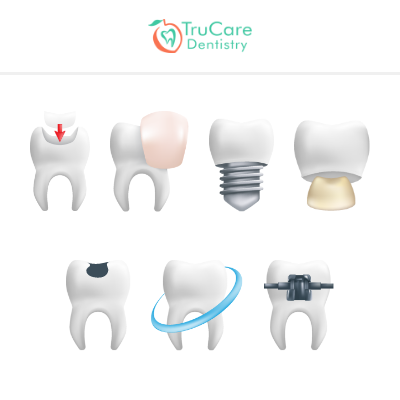
Preventive dentistry is always the better option rather than letting the tooth decay. This leaves you no option but to get the tooth knocked out. There are several tooth restoration procedures you can consider, given the condition of your teeth, ranging from simple to complex. Any office offering general dentistry services should be capable of handling tooth restoration. Consider these seven different types of tooth restoration procedures.
1. Bonding
Over time your teeth may become chipped, cracked, and discolored. The simple procedure of bonding restores teeth to their pristine condition. Fix an appointment with an office offering general dentistry services to undergo this procedure. It can be done within an hour or so. Your dentist will choose a resin shaded to match the color of your teeth, put it in place and then use ultraviolet rays to harden the resin. However, this is not a long-term solution. Resin can chip and break, requiring repairs. Still, it does help to prevent further damage to teeth.
2. Veneers
If your teeth are crooked, uneven, slightly broken at places, and if there are gaps, then you can remedy this situation by opting for veneers at a general dentistry office. Your dentist will make a mold of your teeth to develop custom veneers that may be transparent or tooth-colored. Before fitting the veneers in place, your dentist will clean your teeth and then grind the surface so that veneers align with the gums. Veneers are affixed with the help of resin and cured with UV. Veneers, with proper care, may last for about 10 years or more. You may need to visit your dentist twice or thrice to complete this procedure and see considerable improvements to your smile.
3. Dental Implants
If a tooth has had to be extracted and there is a gap, it needs to be filled. You can opt for a traditional crown bridge, but the modern and better option is a dental implant. Your dentist at the general dentistry office may use an endosteal type implant or subperiosteal type implant, depending on the structure and strength of the jawbone. A titanium anchor post is fitted inside a hole drilled into the jawbone. An abutment goes over this, and then, finally, a crown made of metal or porcelain is put in place. Implants are quite expensive, take months to complete but are almost permanent.
4. Crown
Suppose you have a tooth that is infected. A root canal can fix the tooth decay issue in the pulp. However, this does leave a hole on the surface that makes the tooth prone to further infection. In this case, your dentist at a general dentistry office will carry out the root canal procedure, plug the hole with resin and then grind the tooth surface. A crown then goes over the tooth and is cemented in place, protecting your existing tooth for years. Crowns are also ideal for teeth with cavities, weak or cracked teeth, and worn-down teeth.
5. Dental fillings
A cheaper alternative to restore a tooth with a cavity is the use of fillings. Your dentist will clean the cavity and sterilize it, followed by a filling of silver amalgam or resin, or glass ionomer. The use of ceramic and porcelain is also quite common, and these materials are more durable but require more time for the procedure. Dental fillings will protect your tooth against further decay.
6.. Teeth whitening
Should you be habituated to drinking tea or coffee and practice poor oral hygiene, you will notice that your teeth become discolored. Teeth also yellow with age. Even if you use the best toothpaste and whitening pastes, you will find that it is not easy to whiten your teeth at home. It is best to get teeth whitening done at a general dentistry office. Dentists have access to the specialist formula for teeth whitening. First, they put a protective cover over your gums. Then they apply the whitening gel or paste and leave it in place for a half-hour or more. If teeth are highly discolored, they may also use lasers to intensify the bleaching procedure. Alternatively, your dentist may get you to wear trays with a bleaching gel, usually overnight or for a couple of hours at home. This is an easy way to get your teeth restored to sparkling whiteness.
7. Braces and Invisalign
Not everyone is blessed with a set of perfectly aligned teeth. There may be gaps between teeth. Your teeth may be crooked and out of alignment and may protrude inward or curve inwards. In these situations, your orthodontist at the general dentistry office may recommend several procedures.
- Braces: Braces are usually made of metal that goes on to the teeth, and then these are held and drawn together with steel wire.
- Lingual braces: Traditional braces are applied to the outer surfaces and may look unseemly. Lingual braces are installed behind the teeth and are not easily visible. Your dentist will likely change and readjust the branches in both cases as our teeth fall into alignment. In both cases, you also have the option of use of ceramic instead of metal.
- Invisalign: Your dentist will make a mold of our teeth and prepare a set of clear transparent polycarbonate or acrylic aligners. You can keep them on all the time, removing them at mealtimes or night. IT takes about six months and a change of sets to improve the alignment of crooked teeth.
Dental procedures, even basic ones like filling and bonding, are expensive. Crowns, bridges, Invisalign, and implants can be even more so and may not be covered by insurance. The best thing to do is keep visiting your dentist at regular intervals for preventive dentistry and retain your natural teeth right up to a ripe old age.
